家禽养殖场鸡舍照明指南
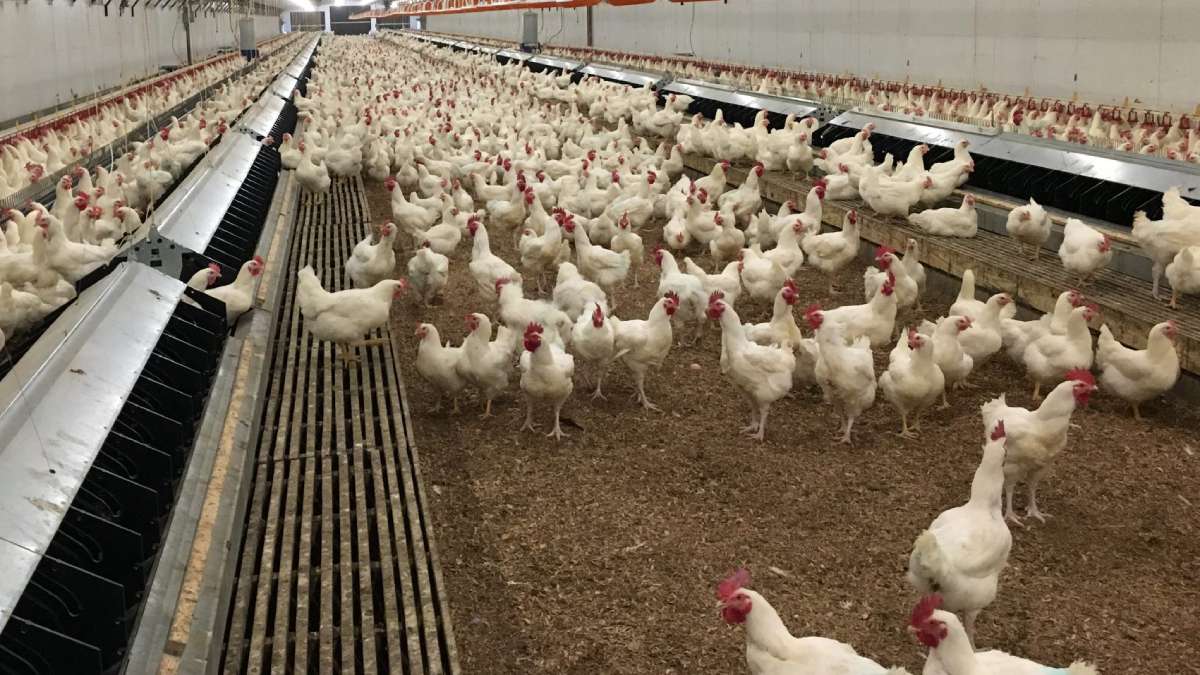
高效的鸡舍照明是现代家禽养殖场最重要的因素之一。无论您是 养殖蛋鸡产蛋 还是 肉鸡产肉,合理的 光照管理 都会影响鸡的生长、饲料转化率、应激反应和整体生产性能。
与人类不同,鸡可以看到更宽的光谱,包括紫外线,这意味着照明必须根据它们的生物需求进行调整。
在本指南中,我们将解释不同的光颜色如何影响家禽的行为和生产性能,概述蛋鸡和肉鸡的实用照明方案, 并展示定时器和光谱仪等工具如何帮助农民获得稳定、盈利的结果。
目录:
1. 为什么鸡舍照明很重要?
对家禽而言,光照不仅仅是提供可见光。它还控制着采食、生长和产蛋周期。家禽依靠稳定的光照来调节生物钟,这反过来又会影响其生产性能。
对于肉鸡而言,合理的照明方案能够促进稳定的采食量和均衡的体重增长。对于蛋鸡而言,合适的光照时长和光谱直接影响蛋的大小、蛋壳质量和产蛋稳定性。如果没有可控的LED鸡舍照明,养殖场往往会面临生长不均、应激行为和生产效率下降等问题。
同样重要的是,照明有助于维持大型鸡舍内的秩序。光线充足的环境可以减少攻击行为,使鸡群在特定时间段内保持活跃,并促进鸡群的整体健康。良好的照明并非一种支出,而是对鸡群健康和农场产量的一项投资。
平稳的照明管理是家禽养殖其他各个环节的基础。接下来,我们将探讨鸡的视觉机制以及光谱为何如此重要。
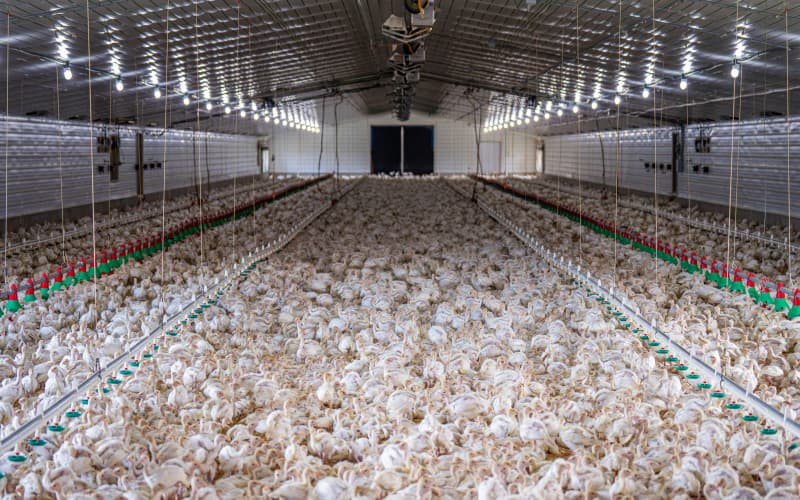
2. 鸡的视觉和光谱基础知识
在这里,我们将学习一些关于家禽照明科学的知识。鸡对光的感知与人类不同。它们的眼睛可以探测到300-700纳米的光谱,涵盖紫外线、蓝光、绿光和红光波长。这种更宽广的光谱范围使它们的视觉能力远远超出我们人类380-750纳米的感知范围。
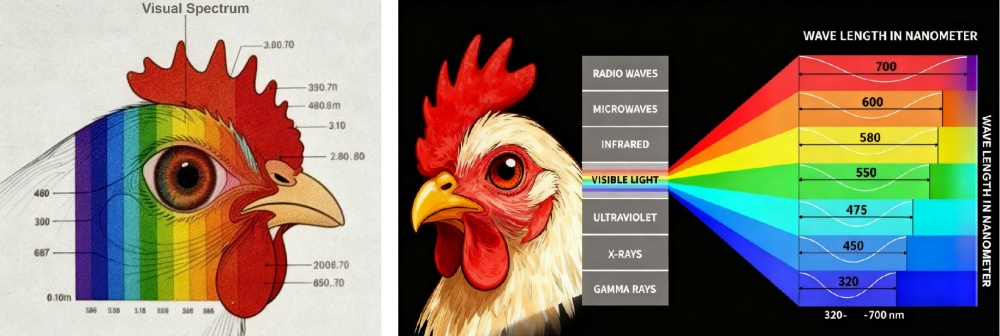
它们的视网膜包含 四种视锥细胞——分别对紫外线、蓝色、绿色和红色光敏感——此外还有 双视锥细胞 ,可以增强对运动和亮度的感知。这种结构使鸡能够评估食物的新鲜度、发现寄生虫,甚至感知鸡群的健康状况。
因此, 光照光谱(而不仅仅是亮度)对家禽的行为和生产性能有着显著的影响。了解这种视觉系统是设计有效鸡舍照明方案的基础。
3. 不同颜色的光照如何影响家禽的生产性能?
现代鸡舍照明灯的功能远不止照明。不同波长的光会直接影响家禽的生长、应激水平、繁殖和蛋品质。了解这些影响有助于农场根据自身的生产目标选择合适的光谱。
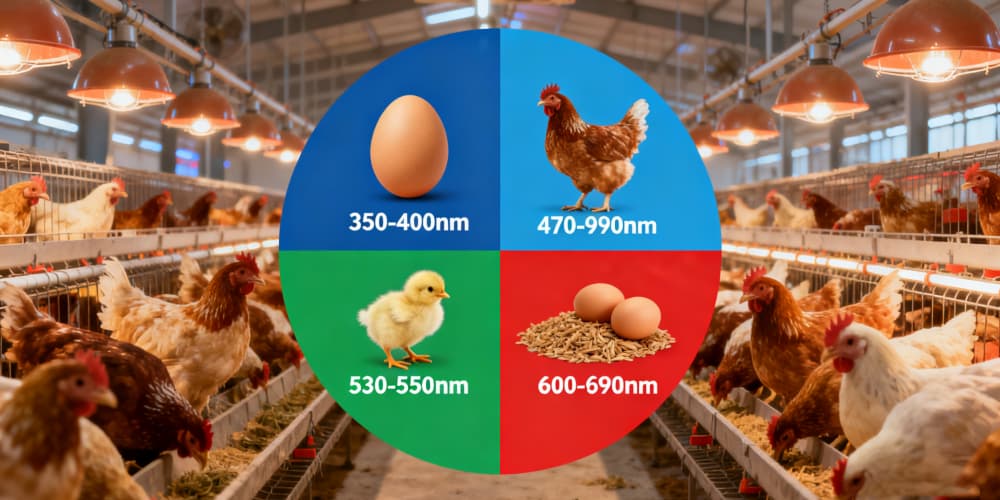
(1)紫外线(UV,350–400 nm)
主要益处:增强维生素D3合成→更好地吸收钙。
结果: 蛋壳更坚固,厚度最多增加 0.05 毫米;软壳率降低到 0.5% 以下。
最佳用途:每天对产蛋母鸡进行 1 小时的紫外线照射。
(2)蓝光(480–490 纳米)
主要益处:降低应激激素,使肉鸡平静下来。
结果:处理过程中逃跑尝试减少了70%;肉质鲜嫩度得到改善。
最佳用法:宰杀前 3 天,可使家禽保持平静。
(3)绿光(530–550 纳米)
主要益处:促进雏鸡肌肉和骨骼生长。
结果: 腿骨长度增加了 8%,生长速度提高了 12%。
最佳用途:肉鸡饲养的前 2 周,每天接受 18 小时以绿色光为主的光照。
(4)红光(660–680 纳米)
主要益处:促进采食量和繁殖。
结果: 采食量提高 20%;施肥率高达 92%。
最佳用途:繁殖和产蛋期,以最大限度地提高生产力。
光照光谱与家禽性能
| 浅色 | 波长(nm) | 主要效应 | 实际结果 | 最佳使用阶段 |
|---|---|---|---|---|
| 紫外线 | 350–400 | 维生素D3合成,钙吸收 | 蛋壳更厚,软蛋更少 | 产蛋母鸡 |
| 蓝色的 | 480–490 | 减轻压力 | 更温和的处理方式,更好的肉质 | 宰前 |
| 绿色的 | 530–550 | 肌肉和骨骼生长 | 体重增加更快,腿部力量更强 | 肉鸡雏鸡 |
| 红色的 | 660–680 | 采食量、繁殖 | 饲料越多,繁殖力越高 | 种鸡和蛋鸡 |
简而言之:策略性地使用特定颜色的鸡舍照明灯可以确保鸡群更健康、产蛋更优质、产量更高。接下来,我们将探讨这些原理在肉鸡养殖中的实际应用。
4. 肉鸡(肉用鸡)鸡舍照明
Broiler lighting must follow two clear stages: brooding (0–2 weeks) and grower/finisher (≥3 weeks to market). Stage-specific spectrum, intensity and cycles drive feed intake, uniformity and final weight.
Spectrum. Use the blue–green range (≈415–560 nm) during both stages to promote growth and feed conversion; fast-growing white strains often benefit from a higher blue ratio (≈480–500 nm).
(1) Intensity & uniformity
Brooding (first week): bright start is critical — 20–30 lux (or ~30 lux at placement) to stimulate feeding and navigation. Keep brightness differences small; aim Uo ≥ 0.5 (min/max) and U₁ ≥ 0.7 (min/avg) to avoid crowding and feed-fight zones.
Growing → finishing: progressively reduce to 10–20 lux (grower) then 5–10 lux (finisher) to lower activity and improve feed efficiency.
(2) Flicker & stability
Use flicker-free LED drivers and high-frequency ballasts; minimize perceptible flicker for birds (recommended practical target: high frequency to avoid physiological effects.
(3) Photoperiod strategy
Start with 23 h light : 1 h dark at placement to encourage feeding and acclimation. From day 4–14, reduce photoperiod gradually toward ~18 h; in finishing, intermittent programs (e.g., cycles of 1 h light : 3 h dark) are proven options to maintain performance while saving energy.
Quick reference — Broiler lighting (practical)
| Stage | Age | Spectrum | Intensity (lux) | Typical cycle |
|---|---|---|---|---|
| Brooding | 0–7 days | 415–560 nm (blue/green) | 20–30 | 23L : 1D (first days) |
| Early grower | 8–21 days | 415–560 nm | 10–20 | Gradually shorten to 16–18 h light. |
| Finisher | 22 days → market | 415–560 nm (more green) | 5–10 | Intermittent options (e.g., 1L:3D cycles) for calm birds & feed conversion. |
5. Chicken Coop Lighting for Egg Production (Layers)
Unlike broilers, which focus on fast weight gain, layers depend on carefully controlled lighting to optimize egg production, shell strength, and laying cycles. Poor light management can delay sexual maturity or reduce overall egg yield.
5.1 Light Spectrum for Layers
Red–Orange Light (600–700 nm): Stimulates the hypothalamus, promoting sexual maturity and ovulation.
Warm White (similar spectrum 2700–3500K): Often used in commercial layer houses to encourage consistent egg laying.
Avoid excessive blue/green dominance: While calming, these can delay laying onset if used alone.
Key Point: Layers need more red light stimulation compared to broilers, as reproduction is the main goal.
5.2 Recommended Light Intensity
Pullet rearing (0–16 weeks): 10–15 lux is enough; excessive brightness causes nervousness and feather pecking.
Laying period (>16 weeks): 10–30 lux ensures hens can see feed, water, and nesting boxes clearly.
Nest area: Slightly dimmer (<10 lux) encourages hens to use nest boxes instead of floor-laying.
5.3 Light Cycle Control
Layers respond strongly to day length. A correct schedule initiates laying at the right age and sustains peak production.
| Stage | Age (weeks) | Photoperiod (h) | Intensity (lux) | Notes |
| Brooding (0–6w) | 0–6 | 20–23L | 10–15 | Long light to stimulate feeding and growth |
| Growing (7–16w) | 7–16 | 8–10L | 10–15 | Short days prevent premature sexual maturity |
| Pre-Lay (17–18w) | 17–18 | 12–14L | 10–20 | Gradual increase prepares hens for laying |
| Laying (>19w) | 19+ | 14–16L | 15–30 | Maintain stable long days to sustain egg yield |
In summary:
Chicken coop lighting for egg production should be red-dominant, stable, and uniform with careful control of day length. A smooth transition from rearing to laying cycles helps prevent early maturity, improves egg shell quality, and maximizes long-term productivity.
6. How to Test, Control, and Improve Poultry Lighting Systems?
Poultry lighting only delivers results when it is measured, adjusted, and tracked. Poultry farms benefit from using the right tools and a consistent management routine.
6.1 Measuring Light Intensity
Lux meters with at least ±5% accuracy are essential.
During brooding, check illuminance at the drinkers and feed trays (20–30 lux recommended).
In the growing and laying phases, measure directly above feed troughs (5–20 lux depending on stage).
Take readings at multiple points to ensure uniformity (Uo ≥0.5) across the house.
6.2 Managing Light Spectrum
Different bulbs deliver different results:
Standard LED white light: balanced red, green, blue spectrum but no UV.
Special UV lamps (350–400 nm, ≥80% UV share): improve calcium metabolism and eggshell quality.
Blue-spectrum tubes (480–490 nm, ≥90% blue share): useful in broiler houses to reduce stress and improve feed conversion.
Best practice: Combine general white LED lighting with targeted spectrum lamps for specific outcomes.
6.3 Timers and Automation
Programmable timers avoid sudden switches on/off that stress birds. Gradual dimming is recommended.
Cycle control: For broilers, use intermittent cycles (e.g., 1h light + 3h dark) in finishing stages. For layers, ensure stable 14–16 hours daily once laying begins.
Central controllers or mobile apps allow precise scheduling across multiple houses, reducing labor.
6.4 Evaluating Lighting Effectiveness
照明本身并不是目的——农场的成果必须证实其成功。
肉鸡:跟踪每日增重、饲料转化率(FCR)、上市时间和胴体质量。
蛋鸡:监测产蛋率、平均蛋重、蛋壳厚度和软壳蛋百分比。
行为线索:聚集不均匀、啄羽或产在地上的蛋可能表明光照均匀性差。
简而言之:持续的测试、光谱管理和自动化调度,能将鸡舍照明变成真正的生产工具。通过将测量与结果跟踪相结合,养殖户可以确保照明投资带来更高的产量和更健康的鸡群。
7. 结论:鸡舍照明的长期价值
鸡舍照明不仅仅是照明——它直接影响家禽的生长、健康和产蛋量。正确的光谱、强度和光照周期管理可以提高肉鸡的饲料转化率,并改善蛋鸡的蛋壳质量和产蛋率。
使用合适的工具、计时器和测量方法,可以确保光照的一致性和均匀性,并将鸟类的压力降至最低。通过定向使用特定光谱的灯光,例如紫外线、蓝光、绿光和红光,可以达到特定的效果,例如增强骨骼、改善行为。
自动化和精细的监控有助于农场维持稳定的光照环境,同时兼顾季节变化和品种差异。通过将光照管理与性能追踪(如增重、饲料转化率、产蛋量和蛋壳质量)相结合,养殖户可以优化生产效率并保障动物福利。
简而言之,鸡舍 LED照明是一项战略性投资。如果实施得当,它能促进鸡群健康,提高产量,并带来 长期的农场盈利能力。
相关产品

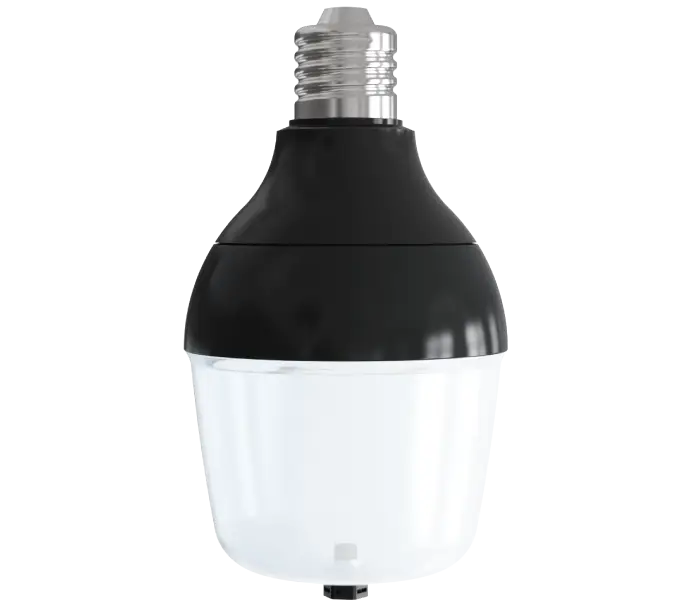
_thumb.jpg)
